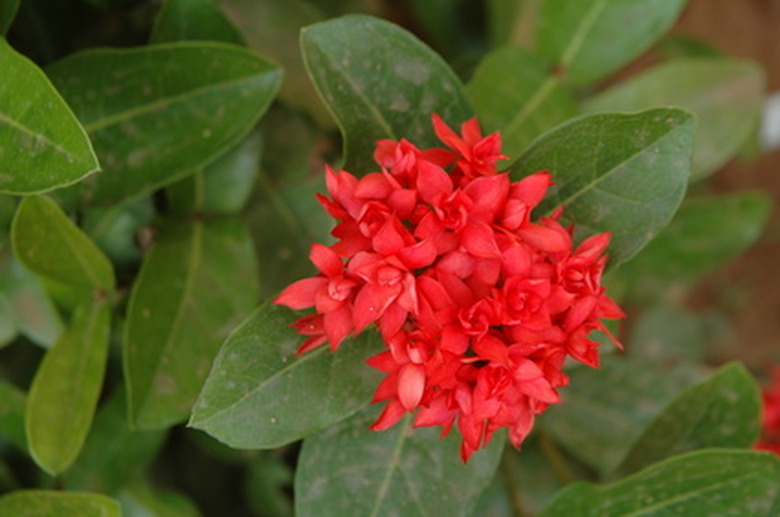Ixora Plant Care
Ixora, also known as flame of the woods, is a bushy plant native to tropical regions of Africa, Asia, Australia and the Pacific Islands. In the United States, these popular landscape plants mostly grow in warm areas such as Central and South Florida. They're commonly used as hedges and are relatively low-maintenance compared to other landscape plants. Ixoras do need some regular care such as pruning and examining their leaves for common pests.
Identification
Ixoras come from a genus making up roughly 100 species of small trees or shrubs. These evergreens are closely related to coffee plants and geraniums. Ixora flowers come in various colors such as red, orange and pink. Their glossy, dark green leaves are some of the most stunning of all flowering plants. There are two basic types of ixoras: Large plants that are a little more than 3 feet tall, and miniature or dwarf plants that are bushy and have small leaves.
- Ixora, also known as flame of the woods, is a bushy plant native to tropical regions of Africa, Asia, Australia and the Pacific Islands.
- Ixoras come from a genus making up roughly 100 species of small trees or shrubs.
Time Frame
One reason ixoras are so popular is that many varieties bloom throughout the year. The time period for maximum flowering runs from spring through early winter, with flowering peaking during the hot months of summer. The best time to fertilize ixoras is early spring, midsummer and late summer. The Florida Plant website recommends applying fertilizer in early spring, midsummer and late summer with an acid fertilizer made particularly for ixoras or gardenias.
Considerations
Ixoras do best in slightly acidic, well-drained soils. When the plant's leaves show signs of yellow areas between green veins, it's due to a soil pH that is more alkaline than acidic, causing manganese and iron deficiencies. Symptoms of seriously neglected ixoras are leaves that have a pure yellow color. The University of Florida Extension Service recommends applying fertilizer containing chelated iron. An even better treatment is placing plants in acidic soils and then addling mulch and organic materials. Although compost should always remain moist, it should never be waterlogged. When watering ixoras, gardeners should be careful not to let soil dry out. Watering should be reduced during winter months.
- One reason ixoras are so popular is that many varieties bloom throughout the year.
- The Florida Plant website recommends applying fertilizer in early spring, midsummer and late summer with an acid fertilizer made particularly for ixoras or gardenias.
Pests
Only a few pests attack ixoras. Signs of an accumulation of microscopic soil pests, such as aphids and scales, are a sooty black mold appearing on leaves. Insecticidal soaps can be used to wash off these pests. Using plenty of organic mulch helps reduce injuries from pests. Stinging caterpillars sometimes bother ixoras, so gardeners need to protect their hands with gloves when hand pruning.
Warnings
Ixoras can be brought indoors for the winter, but they should gradually get used to lower indoor light levels. It's important not to over-water indoor ixoras. Fertilizing should be decreased until they're ready to be returned outside. When ixoras are indoors spider mites can be a problem.
- Only a few pests attack ixoras.
- Ixoras can be brought indoors for the winter, but they should gradually get used to lower indoor light levels.
